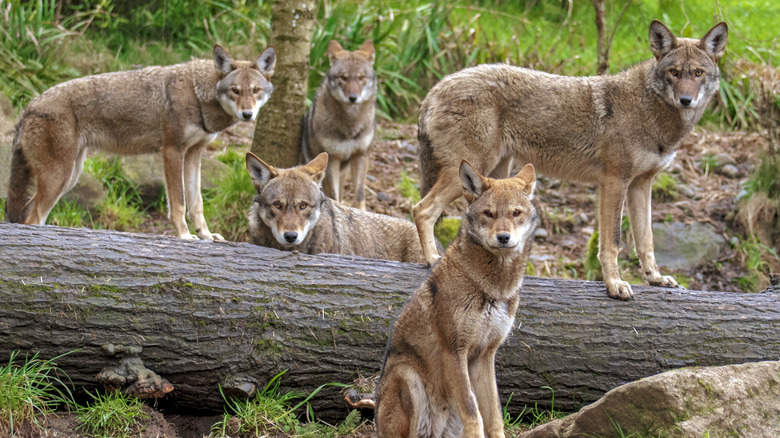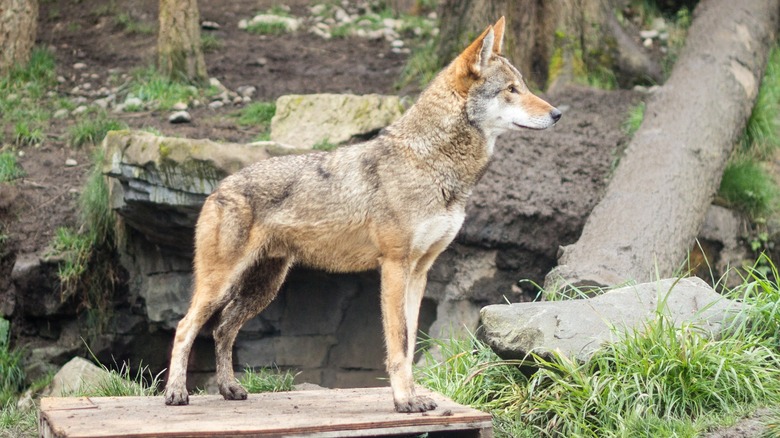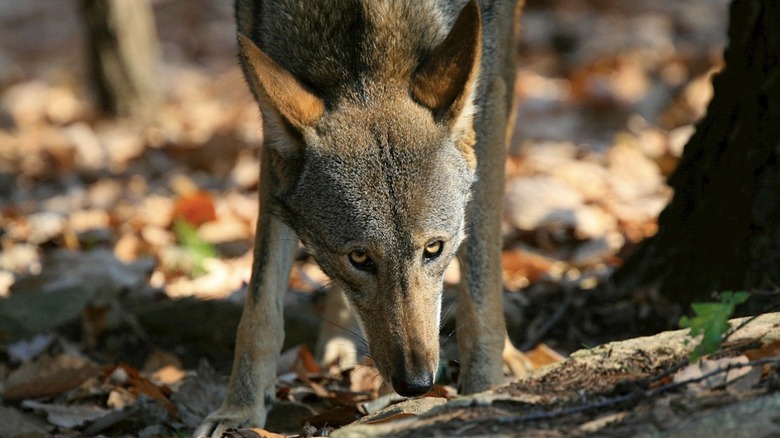You'll Only Find The Rarest Species Of Wolf In North Carolina
Around the world, many species of animals are on the brink of extinction. Some of the rarest terrestrial mammals on the list of endangered animal species include the saola in Laos and Vietnam (~750 individuals), greater bamboo lemur in Madagascar (~1,500 individuals), and golden-rumped elephant shrew in Kenya (~13,000 individuals). But those are rookie numbers. Living in the United States — only in the wilds of North Carolina — the red wolf (Canis rufus) is the rarest wolf species in the world with fewer than 20 individuals in the wild.
The red wolf is the only large carnivore that lives in the United States and nowhere else in the world. Once roaming the U.S. Southeast from Texas to New York, this mammal was nearly eliminated by humans. In the 1700s, wolf bounties were issued and awarded in many states, starting with North Carolina, because the animals threatened livestock. Also, government-sponsored predator control programs allowed people to hunt the wolves as big game. While hunting was the main factor in the American red wolf's rapid decline, it wasn't the only thing that contributed. Its habitat experienced significant changes to the point that it could no longer support the wolves' needs, and hybridization with coyotes diluted their gene pool.
Eventually, the animals were completely wiped out of their wide range except for a small area of their Texas and Louisiana habitat. The government first stepped in to protect the red wolf from extinction in 1967 by listing it as an endangered species, and now, it's only found in one small area — the Alligator River National Wildlife Refuge in North Carolina.
Conservation efforts to save the red wolf
After the initial listing on the endangered species list, the U.S. government started a captive breeding program for the red wolf in 1969. Then, more protections were afforded to the animals through the 1973 Endangered Species Act. The wolves were declared extinct in the wild in 1980 after the U.S. Fish and Wildlife Service spent six years capturing 400 of them for its breeding program, the first large carnivore recovery program of its kind.
Within the program, only 14 of the captured red wolves were used for the species' genetic recovery and are direct ancestors of today's population. They were bred and raised away from humans and then placed in an acclimation area with temporary fencing when they reached adulthood. This gave them a chance to get used to the wild environment, feed on native prey, and grow bonds with potential mates, the latter of which increased their odds of forming a stable pack.
The release process was initiated in 1987 in the Alligator River National Wildlife Refuge in northeastern North Carolina because this protected area has lots of farmland, few livestock, plenty of prey, and no coyotes. More than 60 adults were released through 1994, but the population dwindled again from poaching and vehicle accidents, leaving fewer than 10 wolves in the wild by 2021. Despite that, the recovery efforts continued, and the first red wolf pups born in the wild since 2018 were born in 2021. With more than 40 facilities participating in the captive breeding program as of February 2025, there were 270 wolves in captivity, and around 19 in the wild, 16 of which were collared and tracked.
How to spot a red wolf in the wild
While you could visit one of the participating facilities protecting red wolves — such as the Endangered Wolf Center in Eureka, Missouri — you could have a bit more adventure looking for these kinds of wolves in North Carolina's Alligator River National Wildlife Refuge instead. And, knowing what the animals look like and eat will be essential.
These endangered animals traditionally live in deciduous forest biomes, but can also make coastal prairies and swamps their homes. Generally, they grow to about 26 inches tall at shoulder height and about 4 feet long, and while females average around 50 pounds and males about 60 pounds, the wolves can weigh up to 80 pounds. Despite the weight, the red wolf is a lean species with mostly buff or brown fur on their bodies and some black fur on their backs. Their tails are bushy and have black tips, and the fur on their muzzles, the backs of their ears, and the backs of their legs sometimes have a reddish tint.
Red wolves breed with one mate for life, and their packs of five to 10 individuals form around those mates, creating a tight family. As fiercely territorial animals, they defend and hunt within a home range where their typical prey resides — white-tailed deer and small mammals, such as feral hogs, rabbits, raccoons, and rodents. Because of that, you may see the wolves roaming in areas where these mammals are plentiful. It may take quite a bit of patience and time, though, considering how rare they are.


